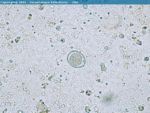Difference between revisions of "Coccidiosis - Dog"
Jump to navigation
Jump to search
(Redirected page to Coccidiosis - Cat & Dog) |
|||
| (5 intermediate revisions by 2 users not shown) | |||
| Line 1: | Line 1: | ||
| − | # | + | [[Image:Isospora canis.jpg|thumb|right|150px|''Isospora canis'' - Joaquim Castellà Veterinary Parasitology Universitat Autònoma de Barcelona]] |
| + | *2 common and 2 less common ''[[Isospora spp.|Isospora]]'' species | ||
| + | |||
| + | *Occasionally can cause disease | ||
| + | |||
| + | *Little pathogenicity | ||
| + | |||
| + | *Even if faecal oocyst count is high, other causes of [[Diarrhoea|diarrhoea]] should be looked for | ||
| + | |||
| + | *''Hepatozoon americanum'' and subclinical ''H. canis'' in [[Bones Hyperplastic and Neoplastic - Pathology#Hepatozoon|periosteal bone formation]] | ||
| + | **Both are Tick borne diseases | ||
| + | ***''H. canis'' – ''Rhipicephalus sanguineus'' | ||
| + | ***Ticks become infected by ingesting a blood meal containing macrophages and [[Neutrophils|neutrophils]] infected with the parasite gamonts -> sexual replication in the gut of the tick -> oocysts containing infective sporozoites -> dogs ingest the tick schizogony occurs in numerous tissues[[Category:Coccidia]] | ||
| + | [[Category:Dog] | ||
| + | [[Category:To_Do_-_Stuartd]] | ||
Revision as of 16:28, 14 July 2010
- 2 common and 2 less common Isospora species
- Occasionally can cause disease
- Little pathogenicity
- Even if faecal oocyst count is high, other causes of diarrhoea should be looked for
- Hepatozoon americanum and subclinical H. canis in periosteal bone formation
- Both are Tick borne diseases
- H. canis – Rhipicephalus sanguineus
- Ticks become infected by ingesting a blood meal containing macrophages and neutrophils infected with the parasite gamonts -> sexual replication in the gut of the tick -> oocysts containing infective sporozoites -> dogs ingest the tick schizogony occurs in numerous tissues
- Both are Tick borne diseases
[[Category:Dog]
